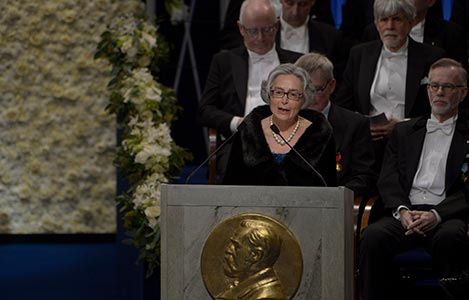Award ceremony speech
English
Swedish
Presentation Speech by Professor Olga Botner, Member of the Royal Swedish Academy of Sciences; Member of the Nobel Committee for Physics, 10 December 2017

Professor Olga Botner delivering the presentation speech for the 2017 Nobel Prize in Physics at the Stockholm Concert Hall.
Copyright © Nobel Media AB 2017
Photo: Pi Frisk
Gravitation is the weakest force we know – yet it is this force that keeps our feet on the ground, determines the orbits of the planets around our Sun and governs the violent encounters of black holes in the distant Universe. The 2017 Nobel Prize in Physics honors a discovery that reflects this apparent discord between strength and weakness in a subtle way: the observation of an incredibly weak distortion of space due to a passing gravitational wave created in a momentous collision between two black holes in a faraway galaxy.
About 1.3 billion years ago, at a time when the first multicellular life emerged on Earth, two black holes with masses close to 30 times that of our Sun entered the final stages of a deadly pas-de-deux. Whirling finally at half the speed of light, they collided and merged – an event which sent gravitational waves speeding through space and time, carrying information on what had just happened. Ever since then, the waves have traveled through the Universe, sweeping through the Earth on September 14, 2015, when they were discovered by the newly commissioned twin detectors of the Laser Interferometer Gravitational-Wave Observatory, designed to notice the tiniest vibrations. This was the first time ever that a passing gravitational wave had been directly observed on Earth. This amazing observation represents the dawn of a new era, opening up new vistas for astronomy and bringing about new possibilities to study gravitation close to black holes where it is at its strongest.
Gravitational waves were predicted about 100 years ago in the framework of Einstein‘s general theory of relativity, which connects gravitation with the geometry of spacetime. They arise as ripples in spacetime whenever objects accelerate, traveling outward from the source as ever weaker waves. When gravitational waves reach the Earth, they stretch and squeeze space by the tiniest amount, far too small to be detected by human senses. Nevertheless, the team of scientists led by this year’s Nobel Laureates succeeded in overcoming the challenge, constructing detectors called laser-interferometers, capable of measuring the microscopic distortions – billions of times smaller than the thickness of a strand of spider silk – in the distance between two mirrors. These interferometers use laser light, split along two arms, each four kilometers long. Mirrors at each end reflect the light back to a point where the two light beams are superimposed. The resulting light wave is channeled to a detector where a pattern of shadows is seen and registered. A passing gravitational wave stretches one of the arms and compresses the other, causing the pattern to shift minutely, which is what the scientists detect.
To exclude local disturbances, like passing trucks or tiny earthquakes causing the instrument to vibrate, the observatory comprises two identical detectors on opposite sides of the American continent, separated by about 3000 km. On September 14, at 9:50 UTC both detectors registered almost identical signals from the passing wave, with less than 7 milliseconds delay. This not only confirmed the signal but allowed localization of its source within an arc on the Southern sky.
The first direct observation of a gravitational wave is in more than one sense an earth-shaking discovery, a breakthrough which has been followed by additional significant observations. It opens unanticipated opportunities to explore hitherto invisible parts of the Universe where according to the renowned astronomer Carl Sagan “something incredible is waiting to be known”.
Professor Weiss, Professor Barish, Professor Thorne,
You have been awarded the 2017 Nobel Prize for Physics for your decisive contributions to the detectors of the Laser Interferometer Gravitational-Wave Observatory and for the observation of gravitational waves. On behalf of the Royal Swedish Academy of Sciences it is my honor and great pleasure to convey to you our warmest congratulations. I now ask you to step forward to receive your Nobel Prizes from the hands of His Majesty the King.
Nobel Prizes and laureates
Six prizes were awarded for achievements that have conferred the greatest benefit to humankind. The 12 laureates' work and discoveries range from proteins' structures and machine learning to fighting for a world free of nuclear weapons.
See them all presented here.
